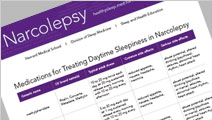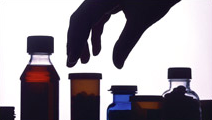The Takeaway
- Medications are a core therapy for most people with narcolepsy. The ultimate goal is to identify medications that produce the greatest benefits with the fewest problems; finding the right balance can take time.
- Sleepiness often improves with modafinil, armodafinil, amphetamines, or oxybates.
- Cataplexy often improves with antidepressants or oxybates.
Medications are a core therapy for most people with narcolepsy, and with optimal treatment, most of them experience large improvements in their alertness. The greatest improvements occur when medications have been optimized, behavioral strategies are used thoughtfully, and any additional sleep disorders are brought under control.

The ultimate goal is to identify medications that produce the greatest benefits with the fewest problems. This can take persistence, as sometimes the first choice is not the best. A reasonable target is to attain normal alertness through much of the day, especially at critical times such as during school or work or when driving.
A summary of medications used to treat narcolepsy and some of their possible side effects can be found in Medications for Narcolepsy (PDF). Detailed information on these medications can be found in the Medications for improving alertness and Medications for improving cataplexy sections that follow.
Dr. Scammell describes the broad classes of medications used to treat narcolepsy.
Medications for improving alertness

For people with mild to moderate sleepiness, modafinil or armodafinil are often good choices. For people with more severe sleepiness, however, amphetamines or oxybates often produce the best results. All these medications have the potential to produce side effects, including some that are severe, so they should only be used as recommended by a doctor.
Some of these medications, such as amphetamines and gamma-hydroxybutyrate (the active ingredient of oxybates), have the potential to be abused. People using high doses recreationally can become addicted and dependent, requiring higher doses of the drug and exhibiting signs of withdrawal when the drug is discontinued. However, addiction or abuse seems very rare in people with narcolepsy taking these medications regularly at the appropriate doses.1, 2
-
Modafinil/armodafinil. Modafinil, a very effective and popular medication for reducing sleepiness in narcolepsy, now comes in two forms: 1) the original formulation (Provigil or generic modafinil) is a mixture of active and inactive compounds, and 2) the newer form (Nuvigil or armodafinil) is the purified active compound.
-
Modafinil likely increases alertness by increasing brain levels of dopamine, a wake-promoting chemical in the brain.
-
Large clinical studies have shown that modafinil and armodafinil reduce feelings of sleepiness as measured by the Epworth Sleepiness Scale, and moderately improve the ability to stay awake on the Maintenance of Wakefulness Test (MWT).3, 4, 5
-
Modafinil usually improves alertness for about eight hours, so most people find it convenient to take the medication in the morning. Some people find that it wears off in the early afternoon and may prefer to take half of the prescribed dose in the morning and the other half after lunch.
-
Overall, modafinil produces fewer side effects than some of the other wake-promoting medications, but it can cause headache, nausea, and occasionally insomnia. Very rarely, it can produce a severe and dangerous rash that warrants immediate medical attention. Modafinil also makes birth control pills much less effective, so women taking modafinil should use an alternate method of birth control.
-

This two-page PDF provides detailed information on medications used to treat symptoms of narcolepsy. Amphetamines and related medications. Since the 1930s, amphetamines have been used to improve alertness in narcolepsy and other conditions. These medications are among the most effective for reducing sleepiness, but side effects are moderately common.
A large variety of amphetamines are clinically available, and individuals may respond better to one than to another. Some of the most common are dextroamphetamine (Dexedrine) and a mixture of amphetamines and dextroamphetamine (Adderall). Methylphenidate (Ritalin, Concerta, Metadate, and Methylin) is closely related to the amphetamines and has similar benefits and side effects.
All these medications improve alertness by increasing brain levels of dopamine. To a lesser degree they can also increase brain levels of two other wake-promoting chemicals, serotonin and norepinephrine.
Most amphetamines are available in short-acting forms that improve alertness for three to four hours, and longer-acting forms that last for six to eight hours. Many people find it most convenient to take the longer-acting form in the morning and sometimes again at midday, with a shorter-acting pill prior to times when sleepiness is worst, such as in the late morning or afternoon. Individuals should discuss with their doctors the exact timing and dosing of their medications, to reduce the likelihood of side effects.
At reasonable doses, many people can take amphetamines with little trouble, but these medications should be used thoughtfully. People with hypertension or heart problems should not take amphetamines, as they can increase blood pressure and heart rate, trigger heart problems, and, very rarely, cause sudden death. Amphetamines can disrupt sleep, cause headaches or anxiety, and, rarely, trigger altered thinking such as mania or psychosis. Amphetamines can also be abused. For most people this is not a concern, but the medication should be taken only in the way your doctor recommends.
At very high doses, such as those used by people who abuse methamphetamine, amphetamines can injure the brain.6 However, there is no evidence that brain injury occurs in narcolepsy patients who take amphetamines at moderate doses on a regular basis.

Medications are a core therapy for most people with narcolepsy. Solriamfetol. Solriamfetol is a new medication that is taken in the morning and can improve alertness across the day. This drug works by increasing brain levels of norepinephrine and dopamine. Clinical trials have shown that it substantially improves subjective alertness and the ability of people with narcolepsy to stay awake on the Maintenance of Wakefulness Test. It should not be taken with a monamine oxidase inhibitor, and higher doses should not be used in people with impaired kidney function. It is generally well-tolerated, but side effects can include headache, nausea, decreased appetite, increased blood pressure, insomnia and anxiety.
Pitolisant. Pitolisant is another new and unique medication that can improve alertness across the day. It also can reduce cataplexy, hypnagogic hallucination and sleep paralysis. It increases brain levels of histamine, norepinephrine, dopamine and acetylcholine (all of which improve alertness in various ways). It can improve both subjective and objective measures of sleepiness, and its effects can last into the evening. Like modafinil, it can reduce the effectiveness of birth control pills, and an alternate form of birth control should be used. Higher doses should not be used in people with impaired kidney function, and occasionally, it can affect heart function, and your doctor should check an electrocardiogram once you get a stable dose. Side effects are uncommon and include insomnia, nausea and anxiety.
Oxybates. Sodium oxybate (Xyrem), mixed oxybate salts (Xywav), and once-nightly sodium oxybate (Lumryz) are forms of gamma-hydroxybutyrate (GHB), a naturally occurring substance in the brain. Oxybates are quite different from the other medications used to treat narcolepsy. Instead of a pill taken during the day, oxybates are a sedating liquid taken at bedtime. As its effects last only a few hours, a second dose is taken three to four hours later, though with the once-nightly version, it is dosed only at bedtime. Oxybates produce deep sleep through much of the night, and after several weeks of regular use, they usually improve daytime sleepiness and cataplexy.
Doctors generally start oxybates at a low to moderate dose, and then slowly increase the dose over a period of several weeks, if needed.
The mechanism through which oxybates improve sleepiness and cataplexy is not well understood. Research in animals indicates that oxybates produce sedation by binding to receptors for the neurotransmitter GABA. 7 How alertness and cataplexy improve over time is unknown; it is probably not a consequence of deeper sleep, as other sedating medications do not improve the symptoms of narcolepsy.
Several clinical studies have shown that oxybates can reduce feelings of sleepiness as measured by the Epworth Sleepiness Scale.7, 9, 10, 11 With oxybates, people with narcolepsy generally stay awake longer during the Maintenance of Wakefulness Test, although they still fall asleep faster than normal.1, 8 The combination of oxybates and modafinil may be even more effective.12
-
The effects of oxybates on cataplexy is discussed in the Medications for improving cataplexy section of this website.
Oxybates can produce a variety of side effects, including headache, nausea, or dizziness, especially if the person taking it wakes one to two hours after use. Uncommonly, oxybates can produce confusion or depression during the day. It is often quite sedating, so individuals should determine whether they can wake adequately if a child needs attention, a smoke alarm sounds, or they need to go to the bathroom during the night.
Oxybates should never be used in conjunction with alcohol or other sedating medications because the combination is associated with adverse reactions, such as difficulty breathing or coma. Some people with narcolepsy also have sleep apnea, and there is controversy as to whether oxybates can worsen this condition. Some doctors find it helpful to re-evaluate sleep apnea in people taking oxybates.
Dr. Kirsch discusses the role of medications in treating narcolepsy.
Medications for improving cataplexy
Cataplexy occurs in about half of all people with narcolepsy. Among those who have it, some may have only one or two episodes in their whole lives, while others can have 10 or 20 episodes each day. Thus, the decision whether to treat cataplexy with a medication depends on how much impact the cataplexy has on an individual’s life and the expected risks of the medications.
Medications can produce a 90% reduction in cataplexy, and in some patients eliminate it entirely. As cataplexy can have a major impact on social interactions, and sometimes safety, treatment can substantially improve quality of life.
Most of the time, hypnagogic hallucinations and sleep paralysis do not require treatment with medications. However, these symptoms often improve with the medications that reduce cataplexy.
Antidepressants. Antidepressant medications have been used for decades to reduce cataplexy. As there have been no large clinical studies examining the effects of these medications on cataplexy, guidelines on their use are mainly based on the clinical experience of narcolepsy specialists.13
The rationale for using antidepressants is that these medications strongly suppress rapid eye movement sleep, and cataplexy is probably the occurrence of REM sleep paralysis during wakefulness. Antidepressants mainly suppress cataplexy by increasing levels of norepinephrine and serotonin in the brain.
Venlafaxine (Effexor) is one of the most commonly used medications for reducing cataplexy because the dosing is convenient, side effects are uncommon, and it is often very effective. Venlafaxine increases brain levels of both norepinephrine and serotonin.
Fluoxetine (Prozac) is also generally well tolerated and long lasting. It increases brain levels of serotonin and may be slightly less effective than venlafaxine in reducing cataplexy.
Clomipramine (Anafranil) and protriptyline (Vivactil) are very potent in suppressing cataplexy, but they can produce dry mouth, constipation, and other bothersome side effects. Thus, one or the other is often used as an add-on medication for additional cataplexy control. For example, some patients may take venlafaxine as their daily medication for reducing cataplexy, and also take a low dose of clomipramine just before a party for additional protection. People with heart problems, seizures, or glaucoma should not take clomipramine or protriptyline.
Sudden discontinuation of any of these antidepressant medications can produce rebound cataplexy: severe cataplexy that can last several hours. If someone wishes to stop one of these medications, the dose should be gradually reduced.
Oxybates. Oxybates are also very effective in reducing cataplexy. Information on dosing and side effects of this medication can be found in the Medications for improving alertness section of this website.
-

Audrey finds that medications help manage her cataplexy. The mechanism through which oxybates improve cataplexy is unknown. In contrast to the antidepressants, oxybates strongly reduce cataplexy, but they do not reduce REM sleep.
Large clinical studies have shown that oxybates potently reduce cataplexy. In people taking higher doses of oxybates, the average number of cataplexy attacks decreased by 70–85%; people taking lower doses had moderate decreases in cataplexy.9, 11
Even when the dose of oxybates is held steady, it can take up to eight weeks for improvements in cataplexy to become fully apparent.
In contrast to the antidepressants, sudden discontinuation of oxybates do not produce rebound cataplexy. Instead, cataplexy just gradually returns to its baseline level over one to two weeks.
References
- The abrupt cessation of therapeutically administered sodium oxybate (GHB) does not cause withdrawal symptoms. J Toxicol Clin Toxicol 2003; 41:131–5.
- Dauvilliers Y, Bassetti C, Lammers GJ, Arnulf I, Mayer G, Rodenbeck A, Lehert P, Ding CL, Lecomte JM, Schwartz JC; HARMONY I study group. Pitolisant versus placebo or modafinil in patients with narcolepsy: a double-blind, randomised trial. Lancet Neurol 2013; 12:1068–75.
- US Modafinil in Narcolepsy Multicenter Study Group. Randomized trial of modafinil for the treatment of pathological somnolence in narcolepsy. Ann Neurol 1998; 43:88–97.
- US Modafinil in Narcolepsy Multicenter Study Group. Randomized trial of modafinil as a treatment for the excessive daytime somnolence of narcolepsy. Neurology 2000; 54:1166–75.
- Harsh JR, Hayduk R, Rosenberg R, Wesnes KA, Walsh JK, Arora S, Niebler GE, Roth T. The efficacy and safety of armodafinil as treatment for adults with excessive sleepiness associated with narcolepsy. Curr Med Res Opin 2006; 22:761–74.
- Berman SM, Kuczenski R, McCracken JT, London ED. Potential adverse effects of amphetamine treatment on brain and behavior: a review. Mol Psychiatry 2009; 14:123–42.
- Vienne J, Bettler B, Franken P, Tafti M. Differential effects of GABA(B) receptor subtypes, {gamma}-hydroxybutyric acid, and baclofen on EEG activity and sleep regulation. J Neurosci 2010; 30:14194–204.
- Mamelak M, Black J, Montplaisir J, Ristanovic R. A pilot study on the effects of sodium oxybate on sleep architecture and daytime alertness in narcolepsy. Sleep 2004; 27:1327–34.
- US Xyrem Multicenter Study Group. A randomized, double blind, placebo-controlled multicenter trial comparing the effects of three doses of orally administered sodium oxybate with placebo for the treatment of narcolepsy. Sleep 2002; 25:42–9.
- A 12-month, open-label, multicenter extension trial of orally administered sodium oxybate for the treatment of narcolepsy. Sleep 2003; 26:31–5.
- Bogan RK, Thorpy MJ, Dauvilliers Y, Partinen M, Del Rio Villegas R, Foldvary-Schaefer N, Skowronski R, Tang L, Skobieranda F, Šonka K. Efficacy and safety of calcium, magnesium, potassium, and sodium oxybates (lower-sodium oxybate [LXB]; JZP-258) in a placebo-controlled, double-blind, randomized withdrawal study in adults with narcolepsy with cataplexy. Sleep 2021; 44(3):zsaa206.
- Black J, Houghton WC. Sodium oxybate improves excessive daytime sleepiness in narcolepsy. Sleep 2006; 29:939–46.
- Morgenthaler TI, Kapur VK, Brown T, Swick TJ, Alessi C, Aurora RN, Boehlecke B, Chesson AL Jr., Friedman L, Maganti R, Owens J, Pancer J, Zak R. Practice parameters for the treatment of narcolepsy and other hypersomnias of central origin. Sleep 2007; 30:1705–11.